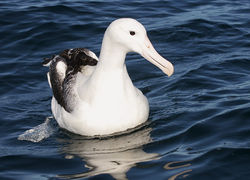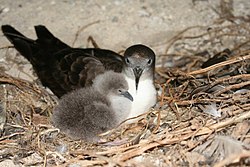Procellariiformes
Procellariiformes is an order of seabirds that comprises four families: the albatrosses, petrels and shearwaters, storm petrels, and diving petrels. They have a cosmopolitan distribution across the world's oceans, with the highest diversity being around New Zealand. Only a single egg is laid per nesting attempt, and usually only a single nesting attempt is made per year, although the larger albatrosses may only nest once every two years. Both parents participate in incubation and chick rearing. Incubation times are long compared to other birds, as are fledgling periods. Once a chick has fledged there is no further parental care.
| Procellariiformes Temporal range: Eocene - Present
| |
|---|---|

| |
| Cape Petrel Daption capense | |
| Scientific classification | |
| Kingdom: | |
| Phylum: | |
| Class: | |
| Infraclass: | |
| Superorder: | |
| Order: | Procellariiformes Fürbringer, 1888
|
| Families | |
Procellariiformes Media
Pterodroma macroptera from Godman's Monograph of the Petrels, 1907–1910
The southern royal albatross is one of the largest of the Procellariiformes.
The white-faced storm petrel moves across the water's surface in a series of bounding leaps.
Christmas shearwaters are one of the surface-nesting tropical procellariiforms.
A semi-precocial wedge-tailed shearwater chick with guarding parent
A Laysan albatross feeds its chick. The parent pumps food from a modified foregut, the proventriculus, and the chick catches the meal in its lower mandible.
A tail-piece engraving in Bewick's A History of British Birds, showing men exploiting birds nesting on sea cliffs, 1804
The poorly known New Zealand storm petrel was considered extinct for 150 years before being rediscovered in 2003.







